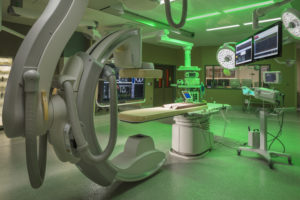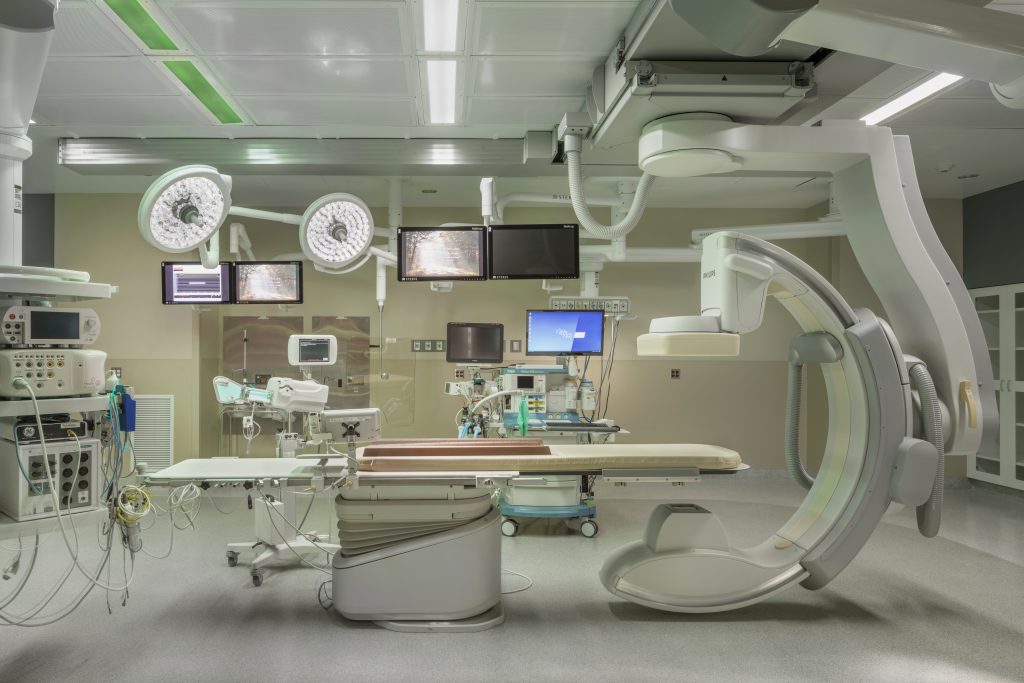Shawnee Mission Medical Center already is seeing the efficiency of its new hybrid operating room, a multidisciplinary space that allows for specialty physicians and nurses to treat patients in one location.
Working with local health care architecture firm Pulse Design, Shawnee Mission Medical Center (SMMC) renovated a clinical area into this state-of-the-art operating room that features the imaging capabilities of a cardiac laboratory (the fixed X-ray system), allowing physicians to perform surgical or catheter-based procedures in a sterile environment with the imaging technology readily available.
Vickie Franck, executive director of the Shawnee Mission Heart and Vascular Center, notes that without a hybrid operating room, physicians would use a mobile fluoroscopy unit, which is subpar imaging for heart-associated procedures.
“The other major reason that Shawnee Mission moved forward with a hybrid OR is that we developed a structural heart program, which we began last year, and that involves taking care of patients that have issues with the structures in their heart such as their valve or their septum,” she said. “In order to perform a procedure called TAVAR, or transcatheter aortic valve replacement, you need to have a hybrid OR.”
Planning in virtual reality
 Lenexa-based Pulse Design has designed many hybrid operating room projects, but SMMC was a defining project for Principal Rick Embers and his team.
Lenexa-based Pulse Design has designed many hybrid operating room projects, but SMMC was a defining project for Principal Rick Embers and his team.
“This was definitely the largest and most complex (project) and provides the most flexibility for the client of any of the hybrid ORs that we’ve done,” Embers said. “So, this one was especially interesting in pure size and making that work for them—and the other part of it was the collaboration amongst everybody that we had on the team.”
Pulse Design was especially advanced in developing SMMC’s hybrid operating room with the use of its virtual reality technology deployed in the planning phase.
According to Franck, the VR allowed physicians and staff who would be working in operating rooms on different procedures to set up each of those procedures under the virtual reality to make sure everything was moving as it should.
“So surgical lights, the clearance of the ceilings—because we have a multitude of monitors and surgical lights in there—and equipment that we had to make sure that all of that could work together without collisions for the multitude of procedures we do in there,” she said.
Angela Suter, Pulse Design architect and project manager for the SMMC hybrid operating room, saw the immediate benefit of reviewing the plans in VR.
“They could see all of that for themselves in 3D form, and they were even able to grab the boom that all the monitors and equipment was on and move them live, just how they would in the actual procedure. So, it was a challenge, but it also opened up this opportunity for us to showcase our technologies,” she said.
Embers added that after the various user groups reviewed the operating room in VR, they redesigned the placement of some of the booms for better function—illustrating the value of the tool.
Local partner
Pulse Design worked with another local firm, United Excel, for general contracting. To minimize disruption at SMMC, most work was completed after hours and on a tight schedule.
“United Excel was selected because of their previous hybrid operating room construction experience, approach to managing a challenging schedule and budget as well as proven expertise with top-notch infection control processes and procedures,” said Lucy Campbell, project manager with United Excel. “The result was a world-class hybrid operating room for Shawnee Mission Health so they could better serve the community.”
The 3,550-square-foot hybrid operating room has been in operation for about two months. Franck and her team already are collecting data on the efficiencies that will arise from its implementation.
“We have seen a growth in our (number of) vascular patients, specifically because we have the ability to provide this service to them,” said Franck. “Any time you do something that’s catheter-based versus an open procedure, the recovery time is much less, so their length to stay in the hospital is definitely less.”

